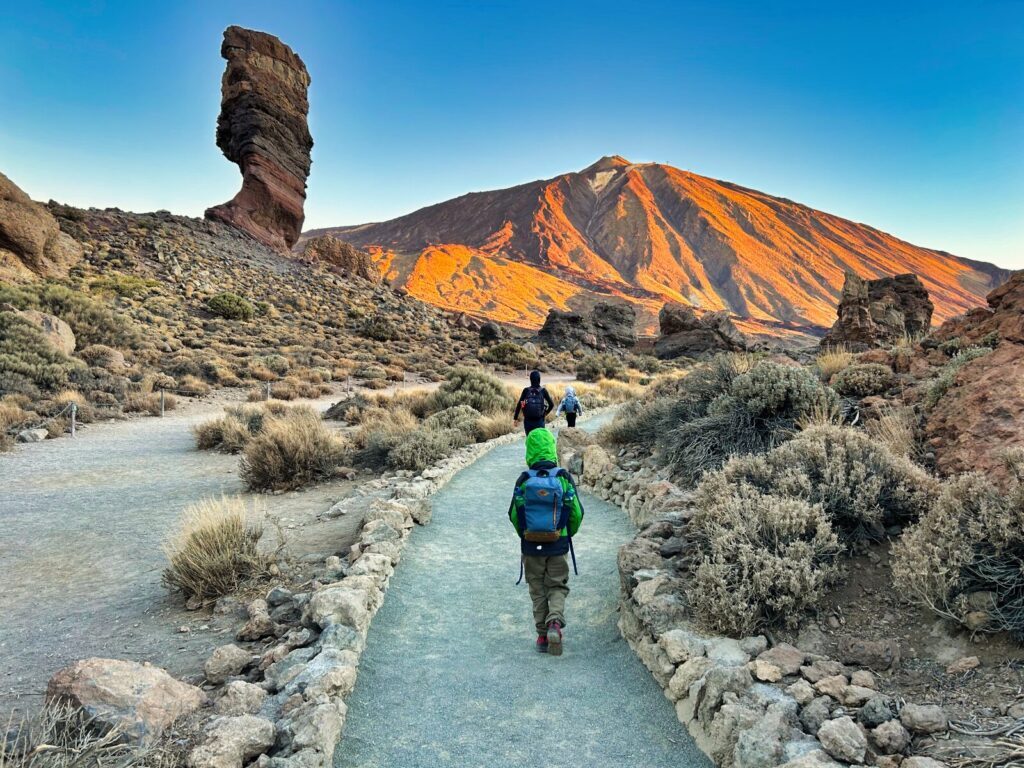Standing majestically at 3715 meters above sea level, Mount Teide represents the ultimate hiking challenge in the Canary Islands and the highest point in all of Spain. This magnificent volcano, rising from the heart of Tenerife like a sleeping giant, offers one of Europe’s most extraordinary climbing experiences. When you plan to climb Mount Teide, you’re embarking on a journey that combines volcanic landscapes, alpine conditions, and breathtaking panoramic views that extend across the entire archipelago and beyond to the African coast.
Our family has conquered the Teide summit multiple times via different routes, and we can confidently say that a Mount Teide hike delivers an experience unlike anywhere else on Earth. From the lunar-like landscapes of Las Cañadas caldera to the final summit push above the clouds, every step rewards you with geological wonders and spectacular vistas that photographers and adventurers dream about.
The key to successfully climbing Mount Teide lies in understanding the permit system, choosing the right route for your fitness level, and preparing adequately for the challenging conditions you’ll encounter. Whether you’re planning to reach the Teide summit via the cable car or prefer the satisfaction of hiking the entire route on foot, this comprehensive guide provides everything you need to know for your successful Pico del Teide adventure.
- Understanding Mount Teide: Spain's Volcanic Giant
- Mount Teide Permit System: Essential Planning Information
- Mount Teide Hike Routes: Choose Your Adventure
- Preparing for Your Mount Teide Hike
- Weather and Seasonal Considerations
- Safety Considerations and Emergency Procedures
- Logistics and Practical Information
- Alternatives When Permits Aren't Available
- Weather Patterns and Best Timing
- Common Mistakes and How to Avoid Them
- Frequently Asked Questions
- Your Mount Teide Adventure Awaits
- Rent our home
Understanding Mount Teide: Spain’s Volcanic Giant
Geological Marvel and UNESCO World Heritage
Mount Teide stands as the third-highest volcanic structure in the world when measured from its oceanic base, making it a geological wonder that has captivated scientists and adventurers for centuries. This stratovolcano began forming approximately 170,000 years ago and remains active today, with its last eruption occurring in 1909 from nearby Chinyero volcano.
The Teide National Park, designated as a UNESCO World Heritage site in 2007, encompasses 18,990 hectares of otherworldly volcanic landscapes. The Las Cañadas caldera, measuring 16 kilometers in diameter, creates a natural amphitheater that houses this magnificent peak and provides the dramatic setting for your Mount Teide hike.
Cultural Significance and Ancient Legends
For the indigenous Guanche people, Mount Teide held profound spiritual significance. They believed the volcano was home to Guayota, a malevolent demon who had captured Magec, the god of light. According to legend, the supreme god Achamán defeated Guayota and sealed him within the volcano, with the white summit representing the cork that prevents the demon’s escape.
Today, this cultural heritage adds mystique to every Mount Teide climb, reminding hikers that they’re not just conquering a peak, but walking through landscapes steeped in ancient mythology and geological history.
Mount Teide Permit System: Essential Planning Information
Understanding Permit Requirements
The most crucial aspect of planning to climb Mount Teide involves securing the necessary permits. The Teide permit system, introduced to protect this fragile volcanic environment, requires advance booking for accessing the summit trail and several approach routes.
Summit Access (Trail 10 – Telesforo Bravo):
- Required for final 163-meter ascent from La Rambleta (3,555m) to summit (3,715m)
- Maximum 200 permits issued daily
- Four time slots: 9:00-11:00, 11:00-13:00, 13:00-15:00, 15:00-17:00
- Special sunrise permits: 6:00-9:00 (50 people daily)
- Special sunset permits: 18:00-22:00 (50 people daily)
- Completely free but requires advance reservation
Approach Trail Permits (Required since January 2025):
- Trail 7 (Montaña Blanca): Most popular hiking route to cable car station
- Trail 9 (Teide-Pico Viejo): Challenging route through volcanic landscapes
- Trail 23 (Los Regatones Negros): Alternative approach with unique geology
- Each trail limited to 50-100 daily hikers
How to Secure Your Teide Permit
Summit Permits:
- Visit www.reservasparquesnacionales.es
- Select “PERMISO ACCESO AL PICO DEL TEIDE”
- Choose your preferred date and time slot
- Provide exact personal details for all participants
- Bring original ID documents that match reservation details
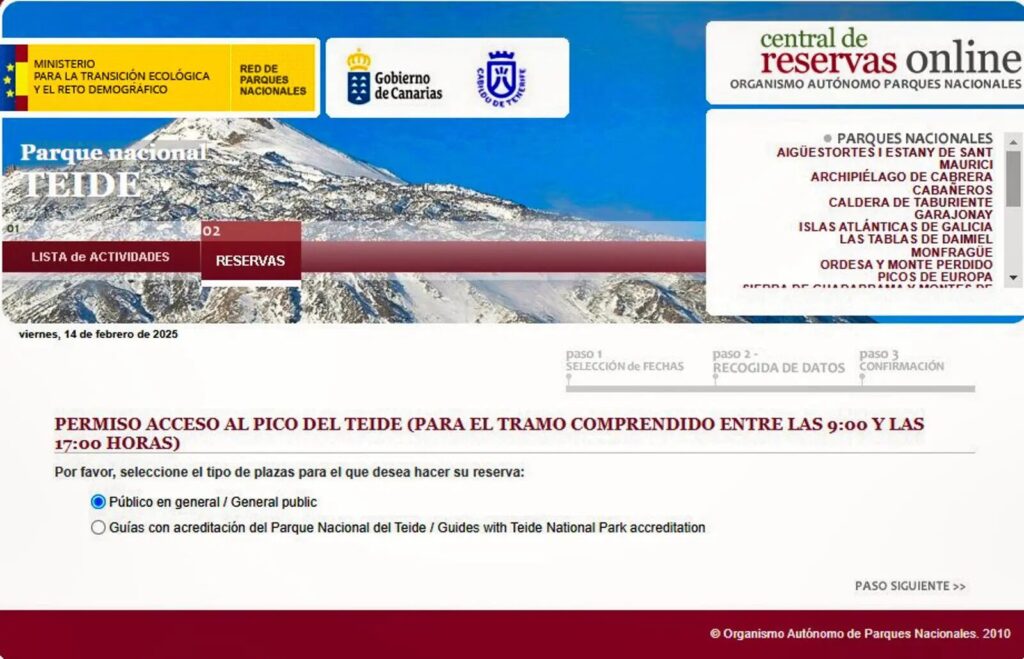
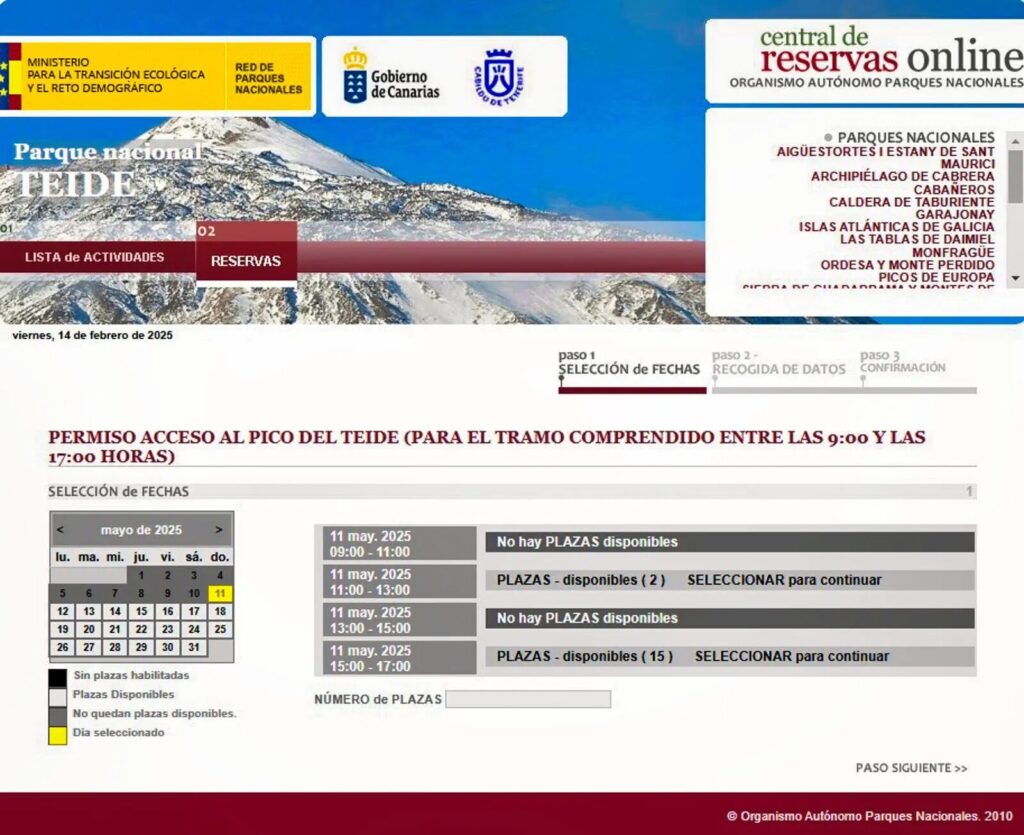
Approach Trail Permits:
- Access TenerifeON platform for trail-specific bookings
- New slots released Mondays at 7:00 AM Canary time
- Reservations available 21 days in advance
- Popular routes fill within minutes of release
Pro Tip: Book permits 3-6 months in advance, especially for peak season (July-September) and sunrise/sunset slots. If permits aren’t available, organized tour companies maintain separate allocations that might offer alternatives.
Mount Teide Hike Routes: Choose Your Adventure
Option 1: Cable Car + Summit Trail (Easiest)
Route Overview:
- Take Teleférico cable car from base station (2,356m) to La Rambleta (3,555m)
- Hike final 650m summit trail with 160m elevation gain
- Total hiking: 30-45 minutes each way
- Total experience: 2-3 hours including cable car time
What to Expect: The cable car journey provides spectacular aerial views of the volcanic landscape while whisking you 1,200 meters upward in just 8 minutes. From La Rambleta station, the summit trail represents a challenging but achievable climb for most fitness levels.
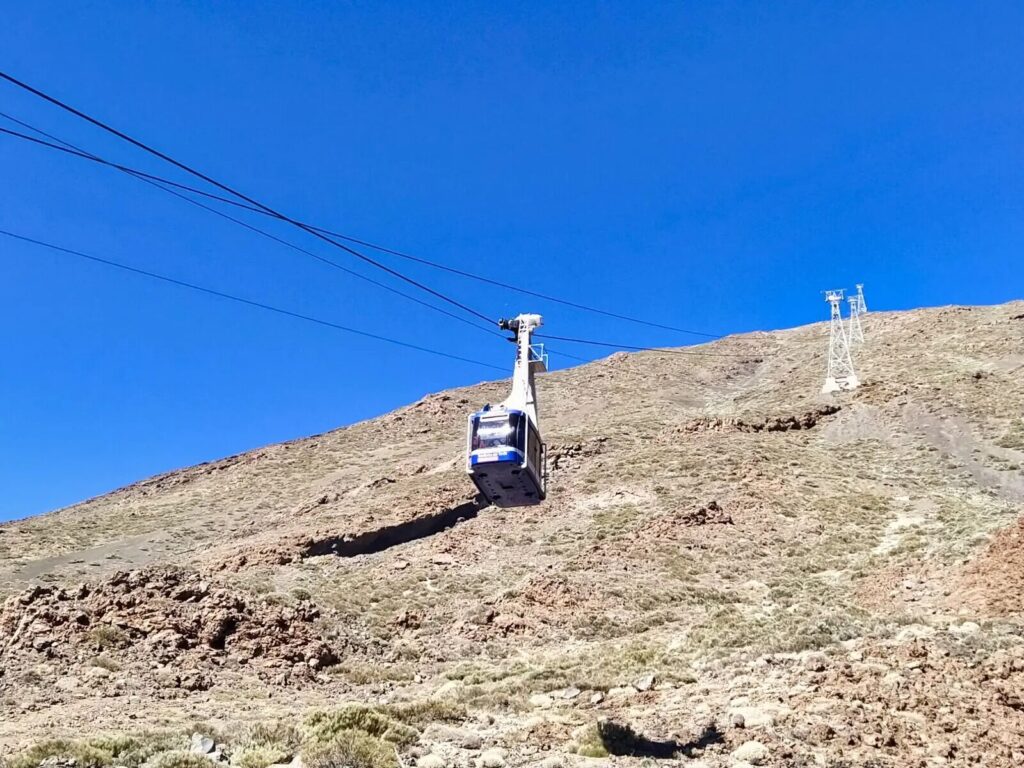
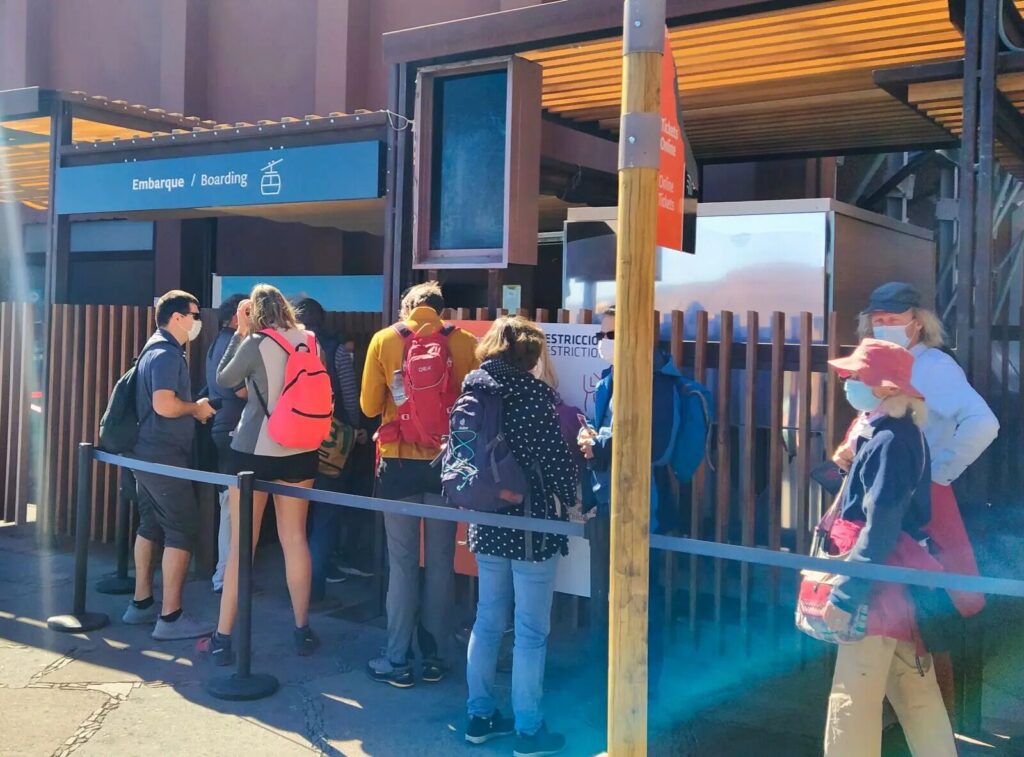
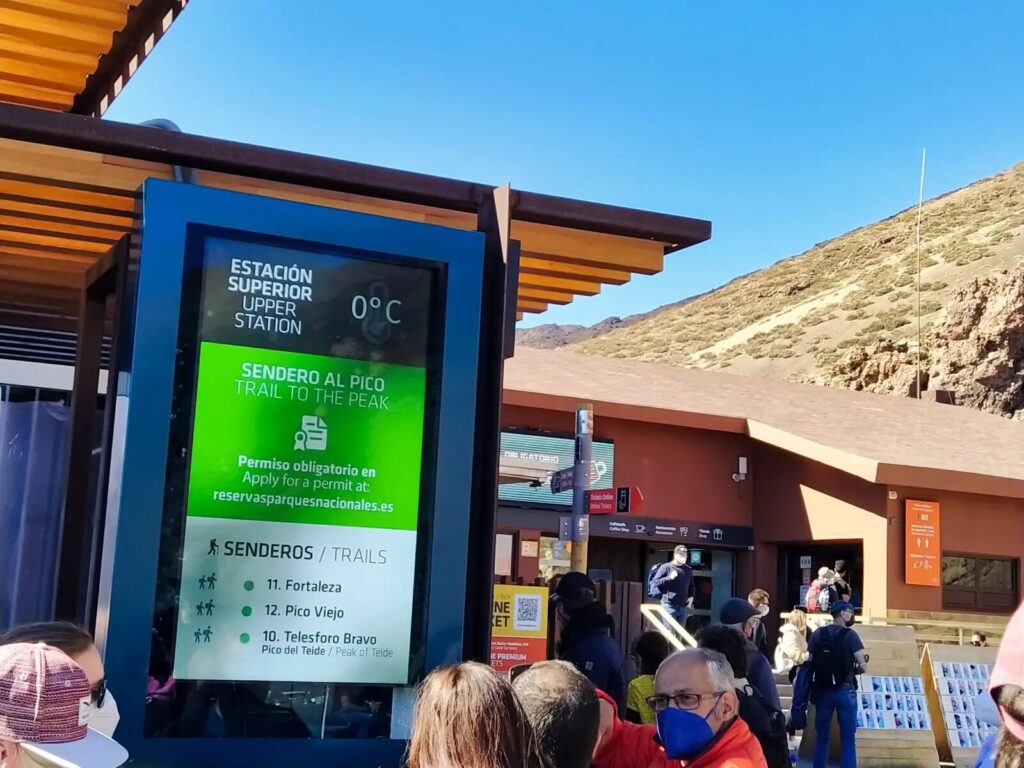
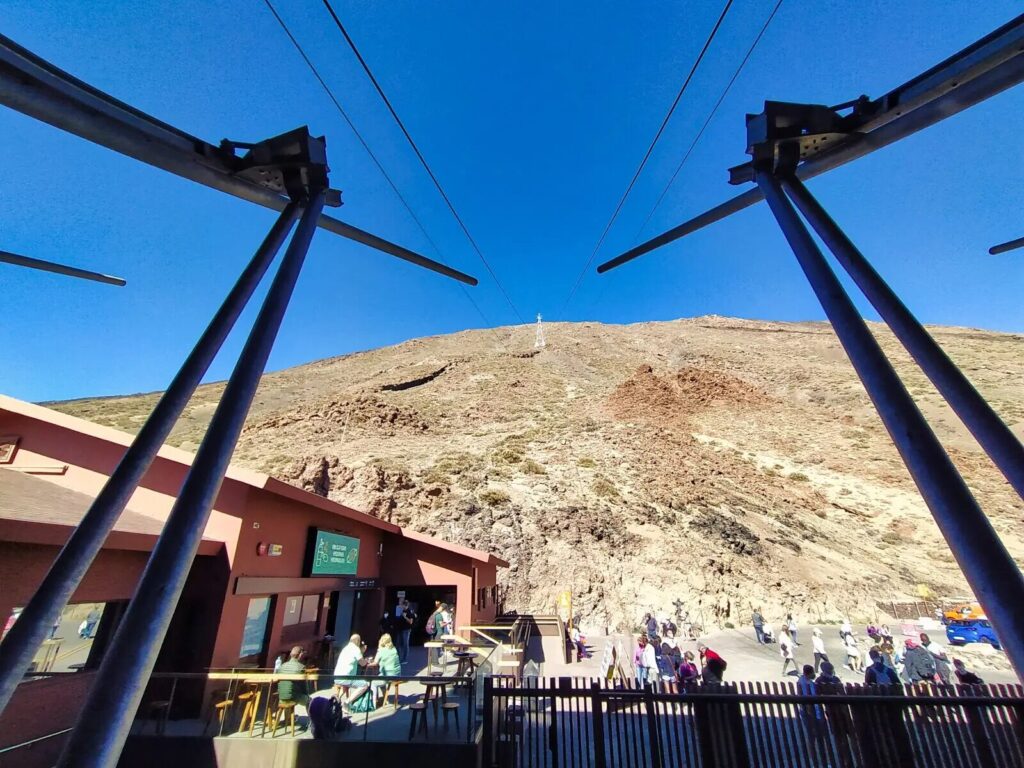
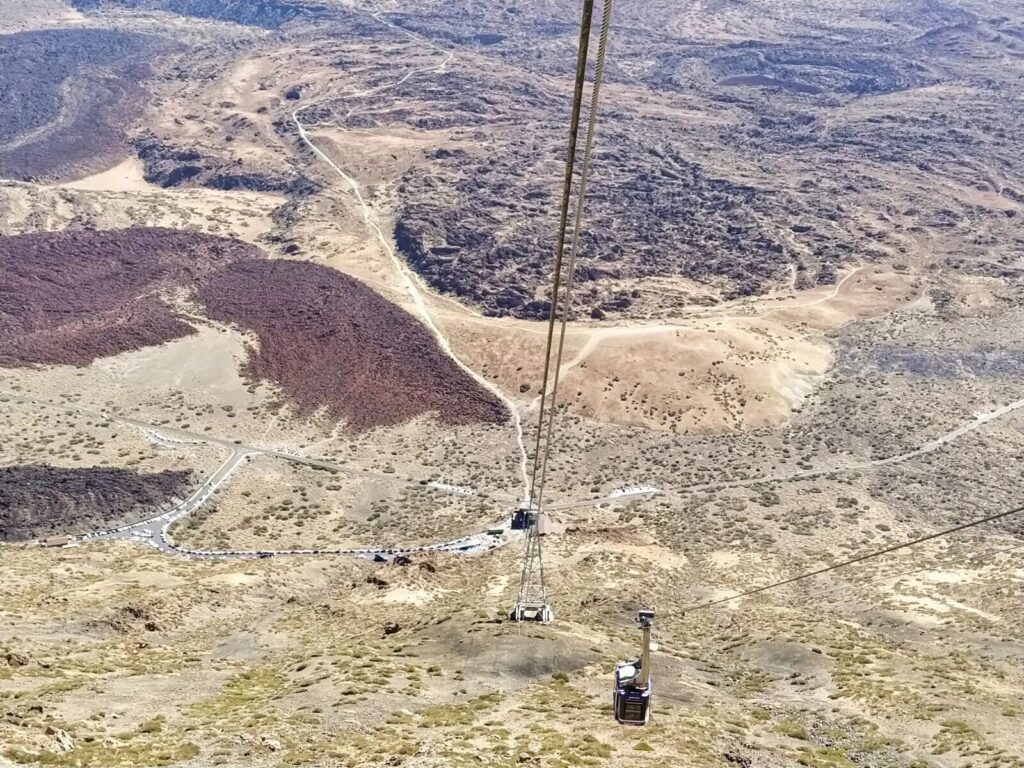
The path zigzags steeply upward through volcanic scree and solidified lava formations. Despite its short distance, the thin air at this altitude makes every step demanding. The final approach offers increasingly dramatic views across the Canary Islands archipelago.
Cable Car Details:
- Operating hours vary seasonally (typically 9:00-17:00)
- Adult tickets: €41 round trip, €23 one way
- Children (3-13): €20.50 round trip
- Book online at volcanoteide.com to avoid queues
- Weather dependent – can close due to high winds
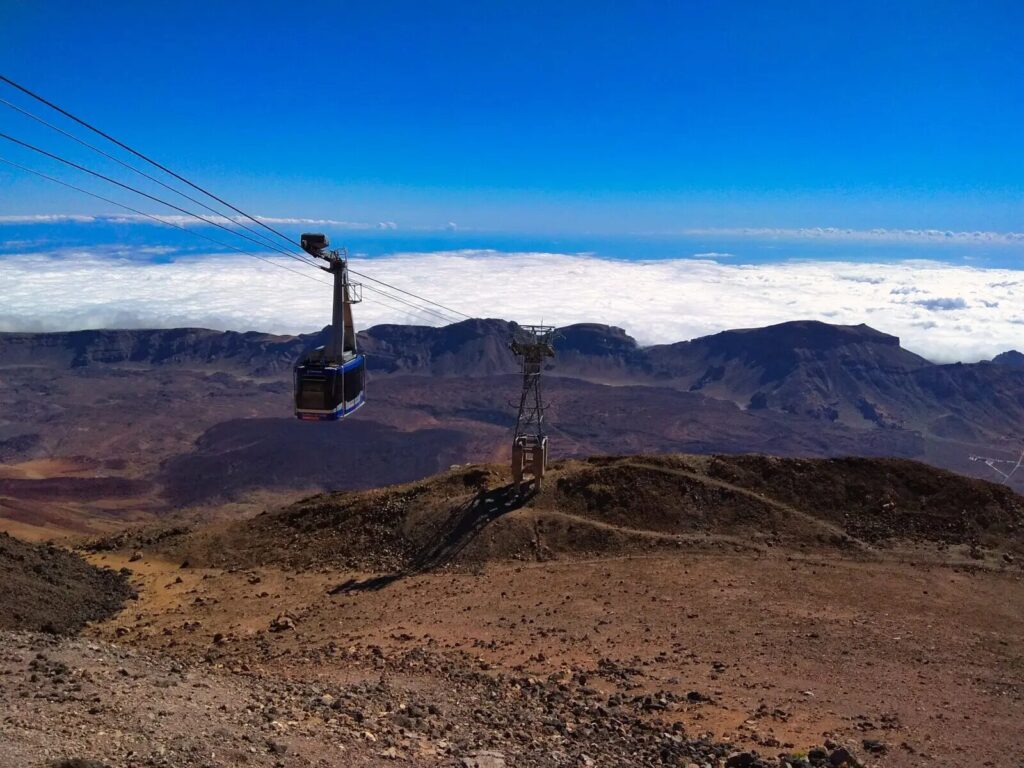
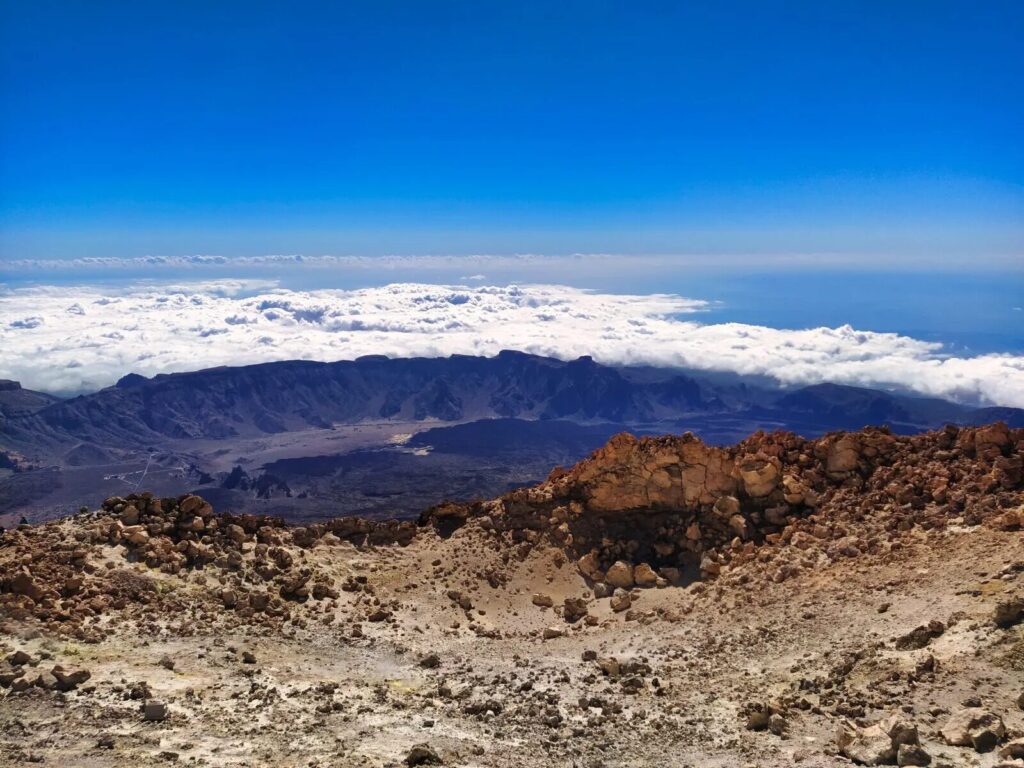
Option 2: Montaña Blanca Trail + Summit (Most Popular)
Route Overview:
- Start: Montaña Blanca parking area (2,348m)
- Distance: 8.3km to La Rambleta + 0.65km to summit
- Elevation gain: 1,367m total
- Hiking time: 5-6 hours ascent + 45 minutes summit
- Difficulty: Challenging due to altitude and distance
Trail Description: This classic Mount Teide hike begins across pumice fields that give Montaña Blanca (White Mountain) its name. The initial 3 kilometers cross relatively flat volcanic terrain, allowing gradual acclimatization to the altitude.
The middle section climbs steadily through sparse vegetation and increasingly dramatic volcanic formations. As you gain elevation, the views expand to encompass the entire Las Cañadas caldera and neighboring peaks.
The final approach to La Rambleta becomes significantly steeper, with switchbacks carved into volcanic slopes. Here, the thin air at over 3,500 meters makes every step challenging, requiring frequent rest stops and steady pacing.
Trail Highlights:
- Diverse volcanic geology from pumice fields to lava flows
- Spectacular views developing throughout the ascent
- Historic Altavista refuge ruins (3,260m) – former overnight shelter
- Junction with cable car passengers at La Rambleta
- Alpine desert ecosystem with endemic plant species
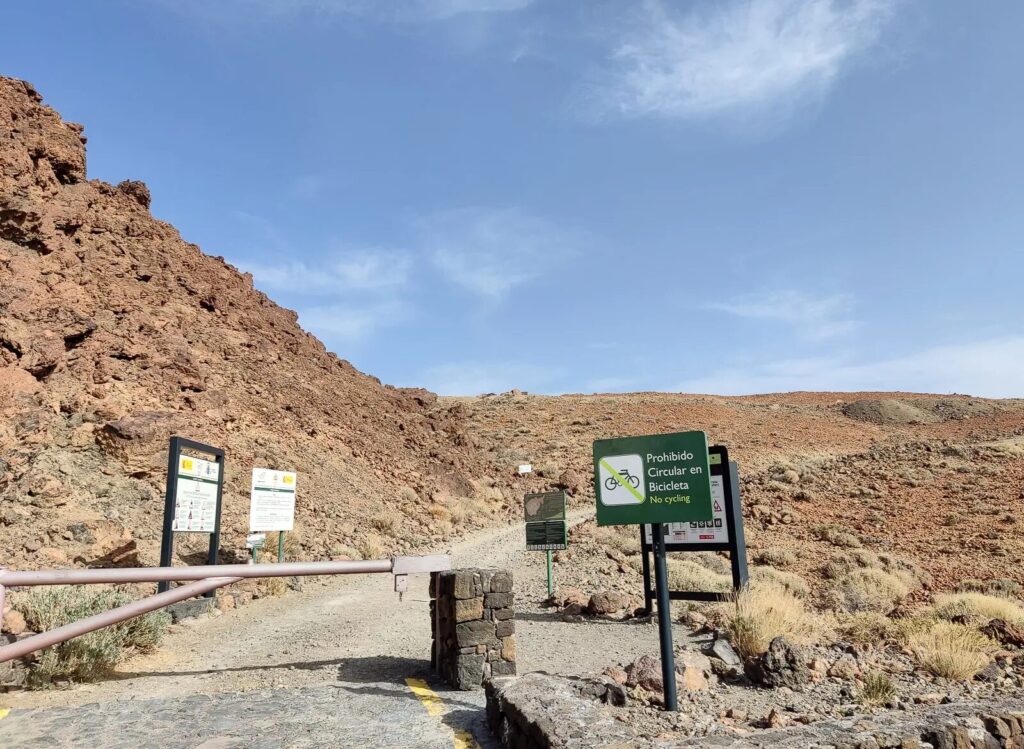

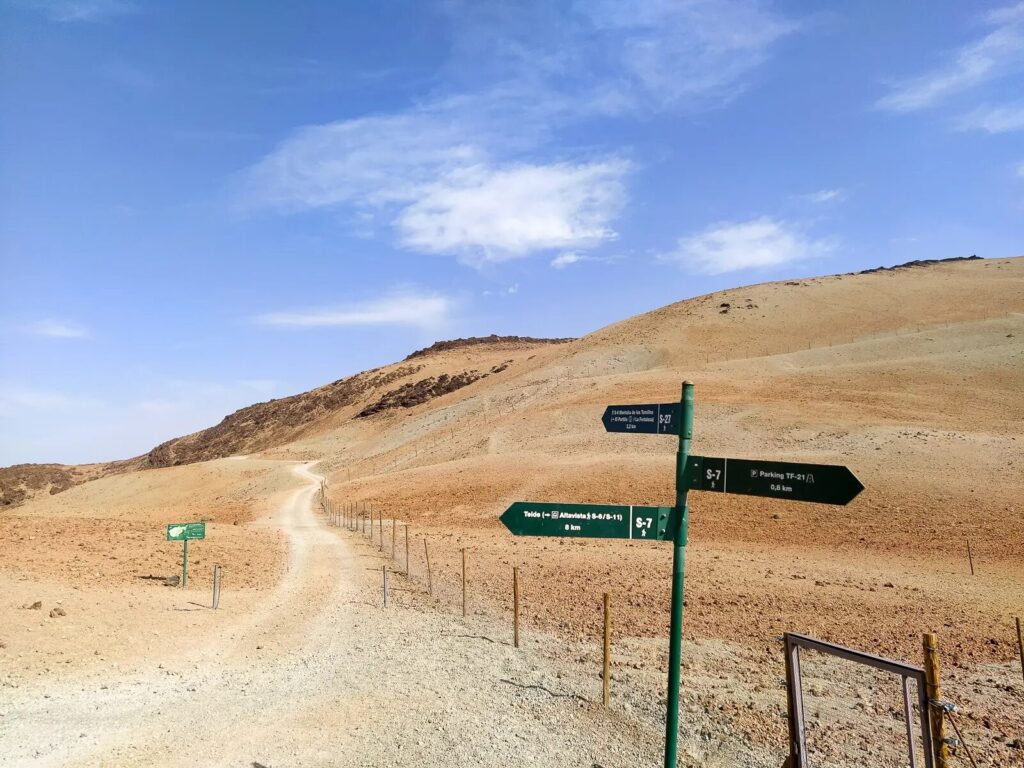
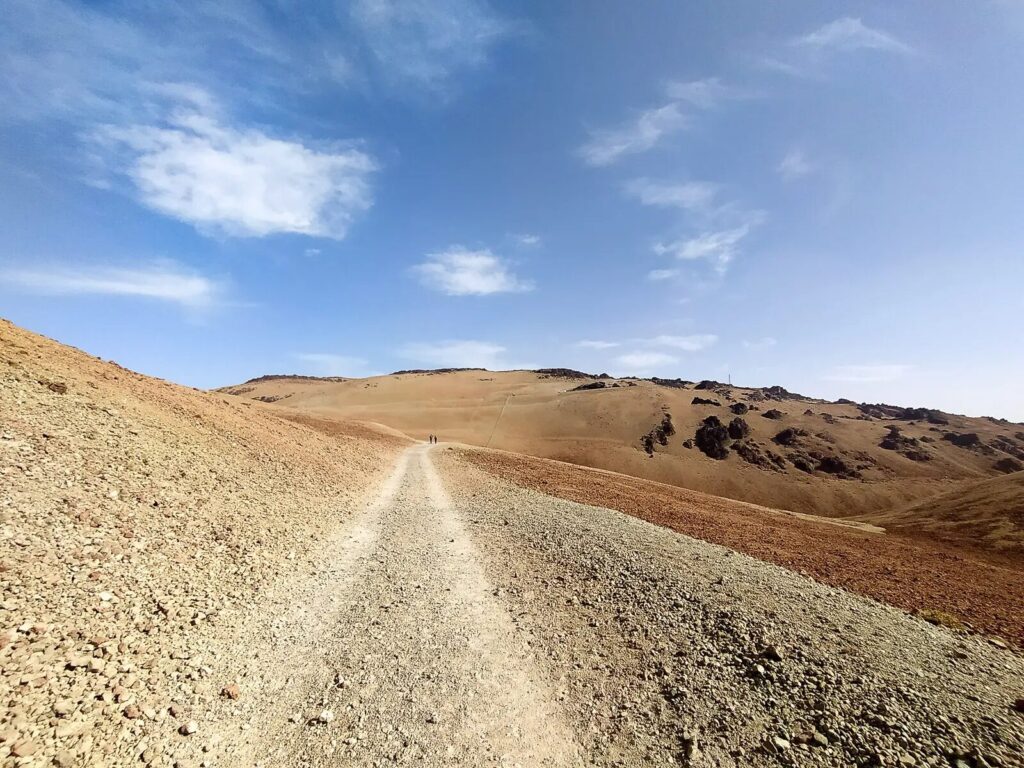
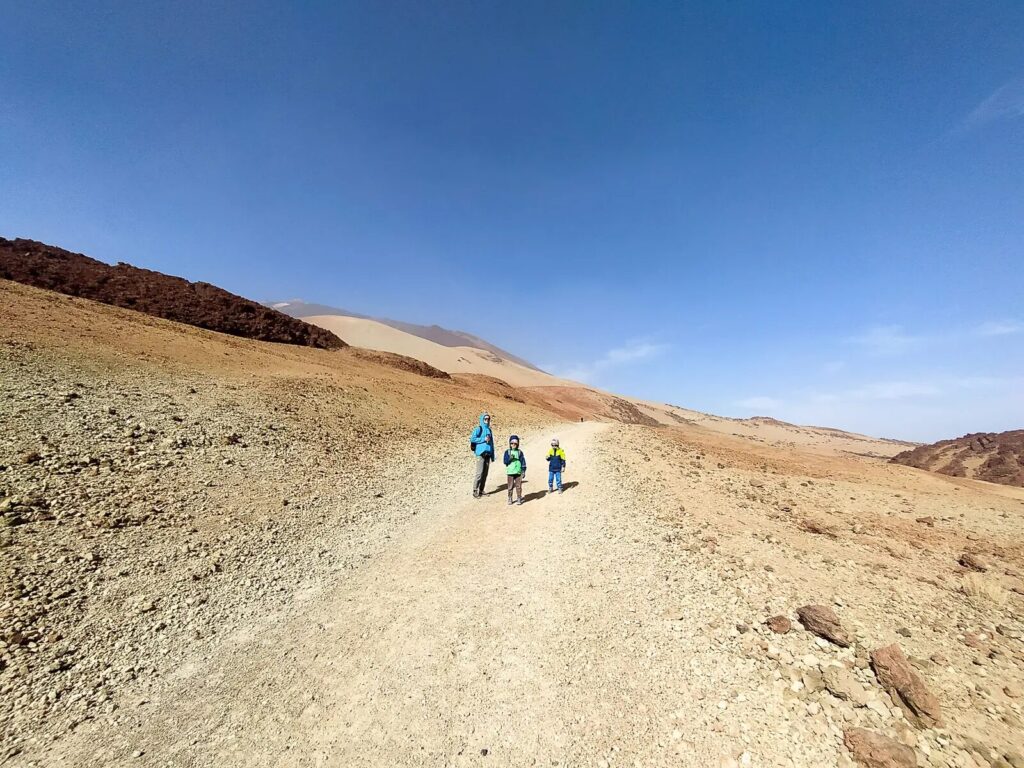
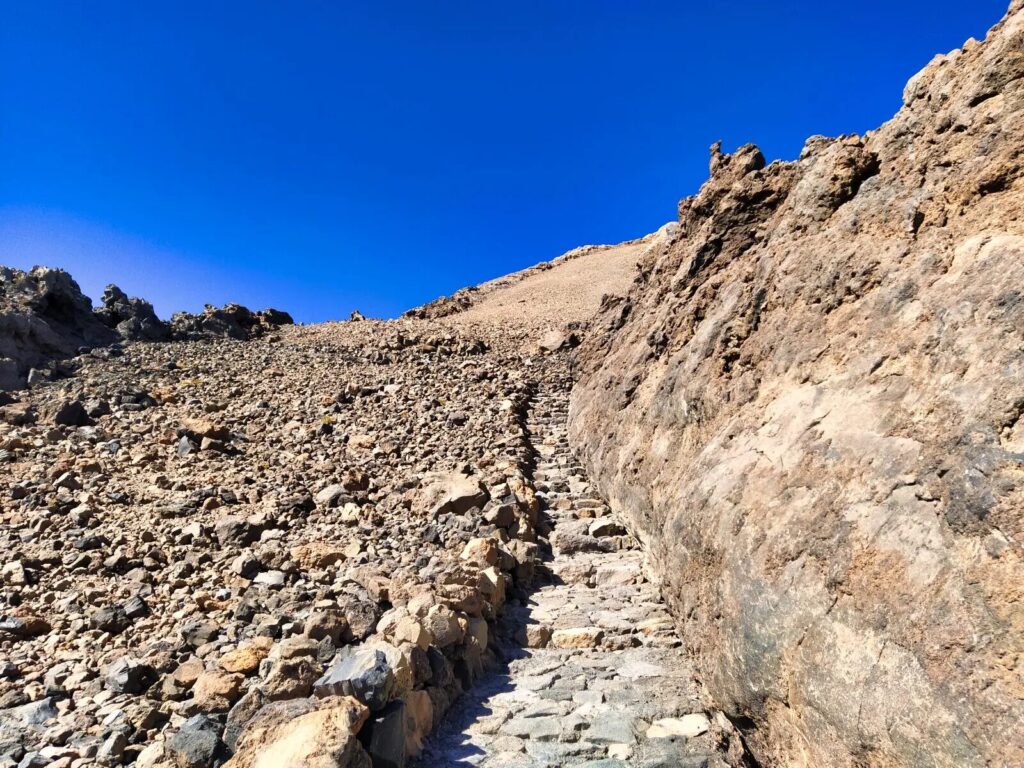
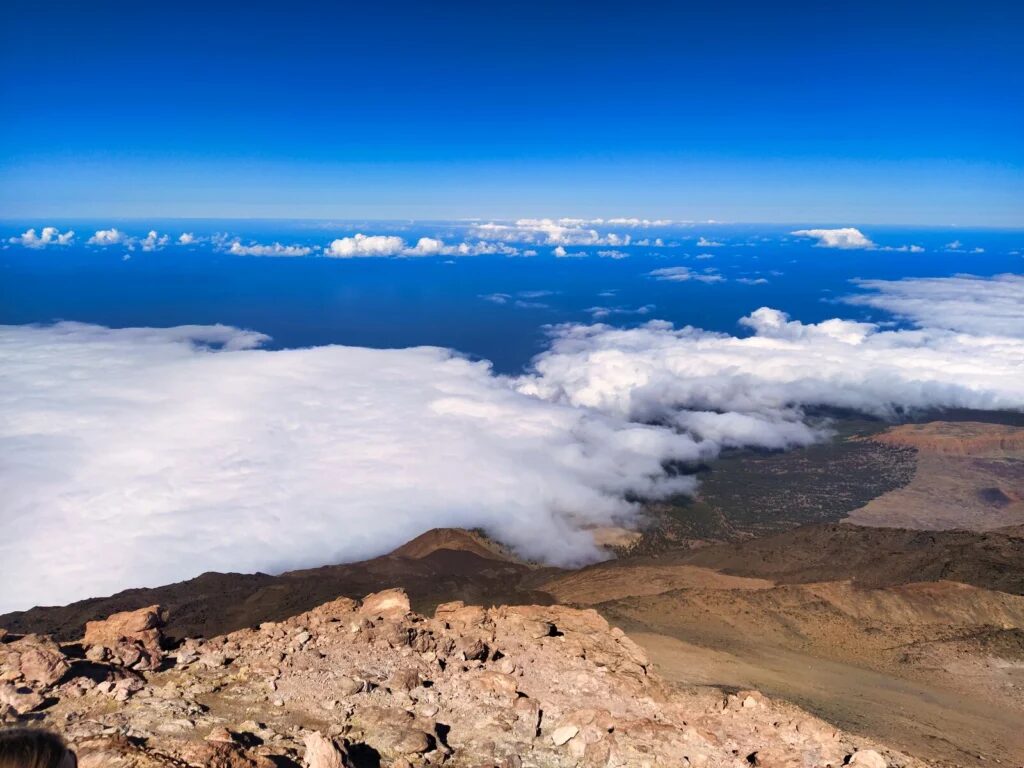
Option 3: Teide-Pico Viejo Trail + Summit (Most Scenic)
Route Overview:
- Start: Near Las Narices del Teide parking (TF-38 road)
- Distance: 9.6km to La Rambleta + 0.65km to summit
- Elevation gain: 1,450m total
- Hiking time: 6-7 hours ascent + 45 minutes summit
- Difficulty: Very challenging – for experienced hikers only
What Makes This Route Special: This demanding Mount Teide climb offers the most diverse and spectacular scenery of any route. You’ll traverse landscapes from the 1798 eruption, circle the massive Pico Viejo crater (800m diameter), and witness the incredible geological forces that shaped this volcanic wonderland.
The route passes Las Narices del Teide (“Teide’s Nostrils”), the volcanic vents from which the last eruption emerged. The multicolored crater walls of Pico Viejo display layers of different volcanic periods – black, red, yellow, and white strata telling the story of countless eruptions.
Advanced Planning Required:
- Requires both Trail 9 permit and summit permit
- Early start essential (6:00-7:00 AM) due to length
- Weather monitoring crucial – exposure to sudden changes
- Navigation skills helpful in poor visibility
- Minimum 4 liters water per person
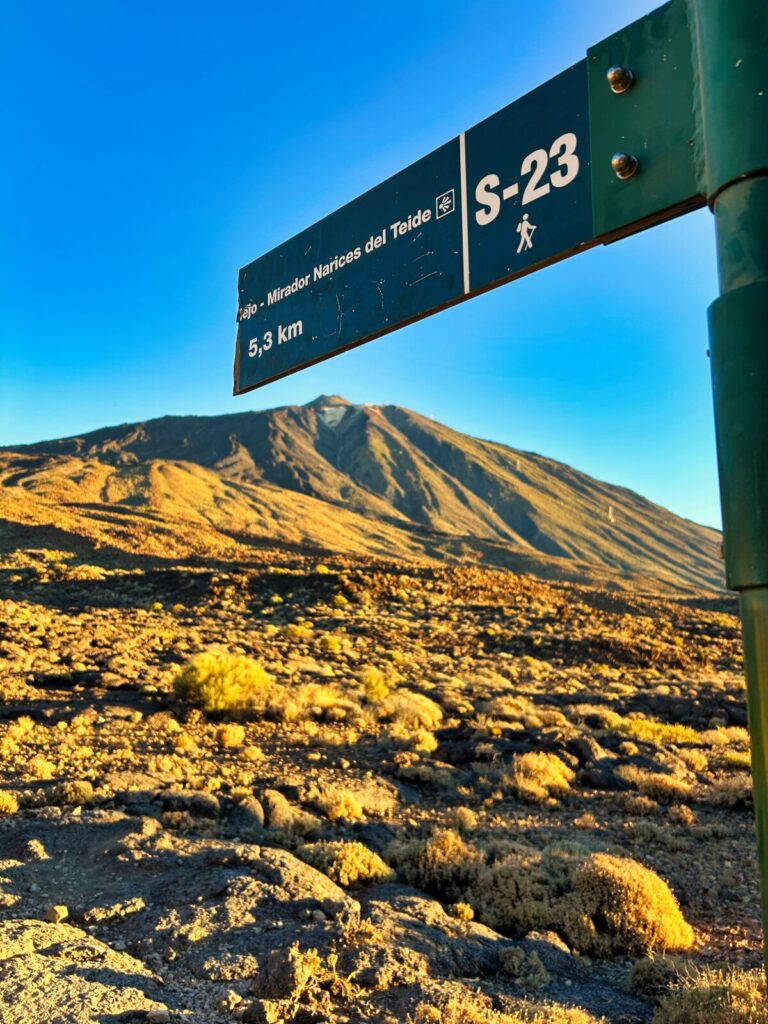
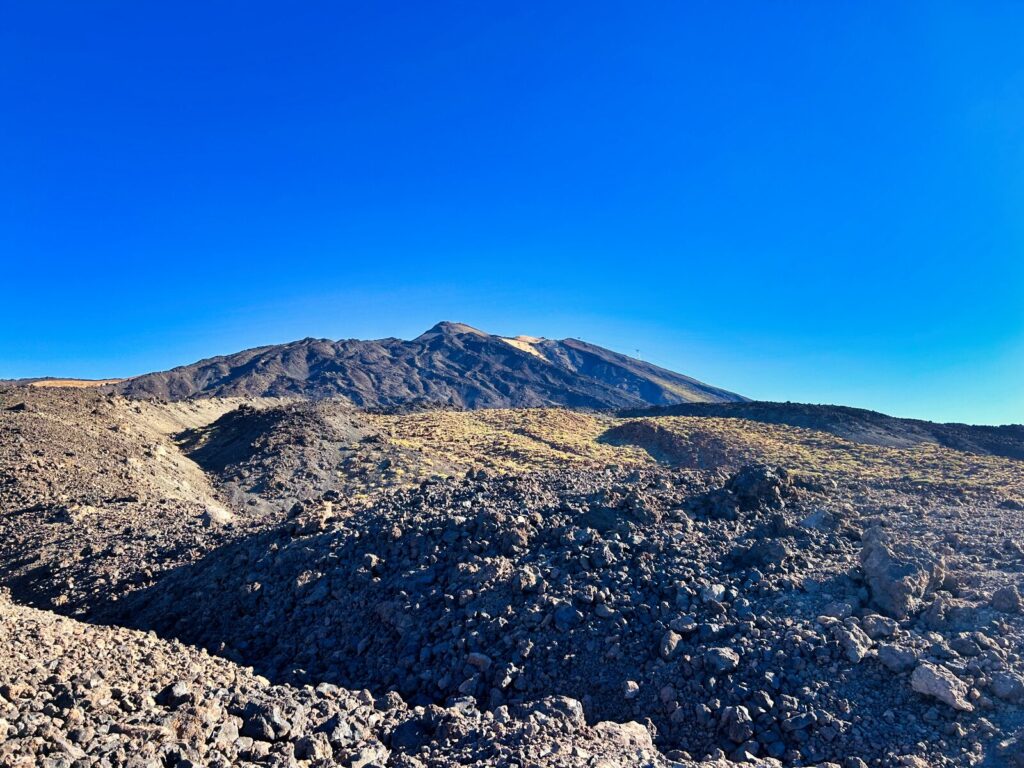
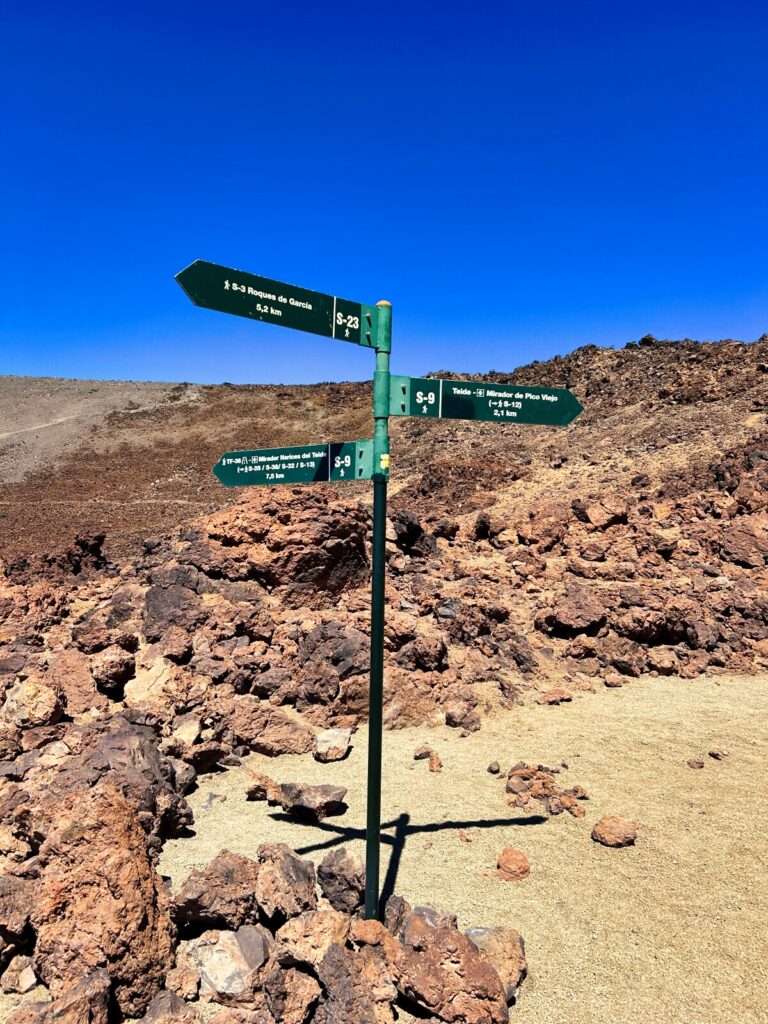
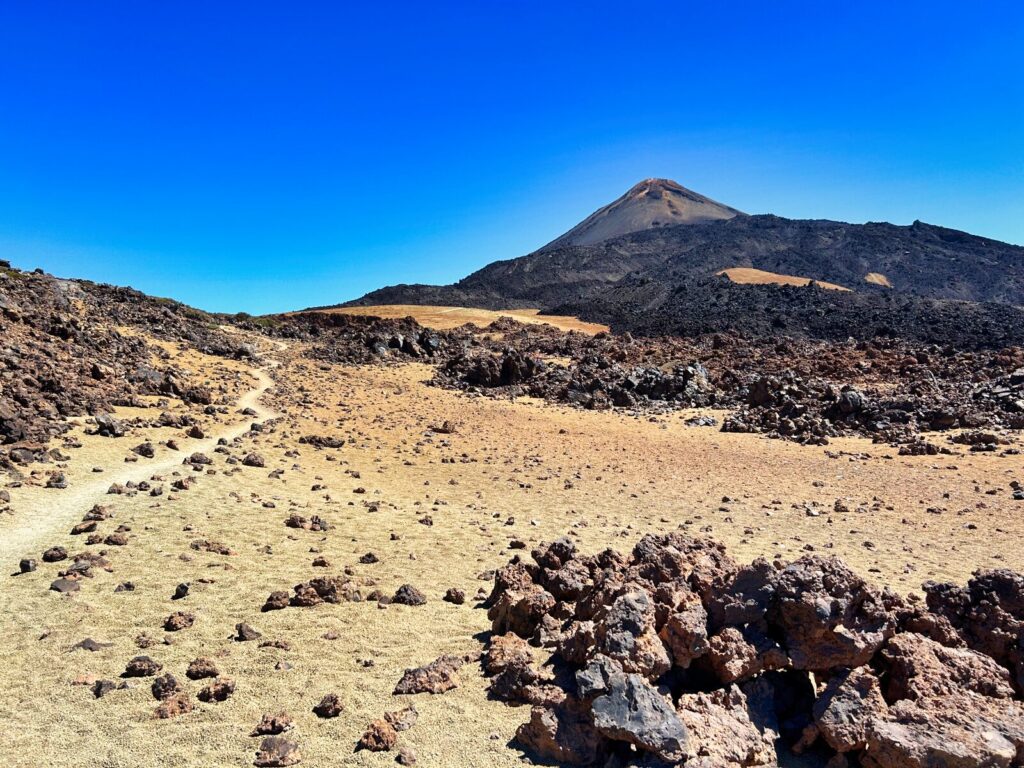
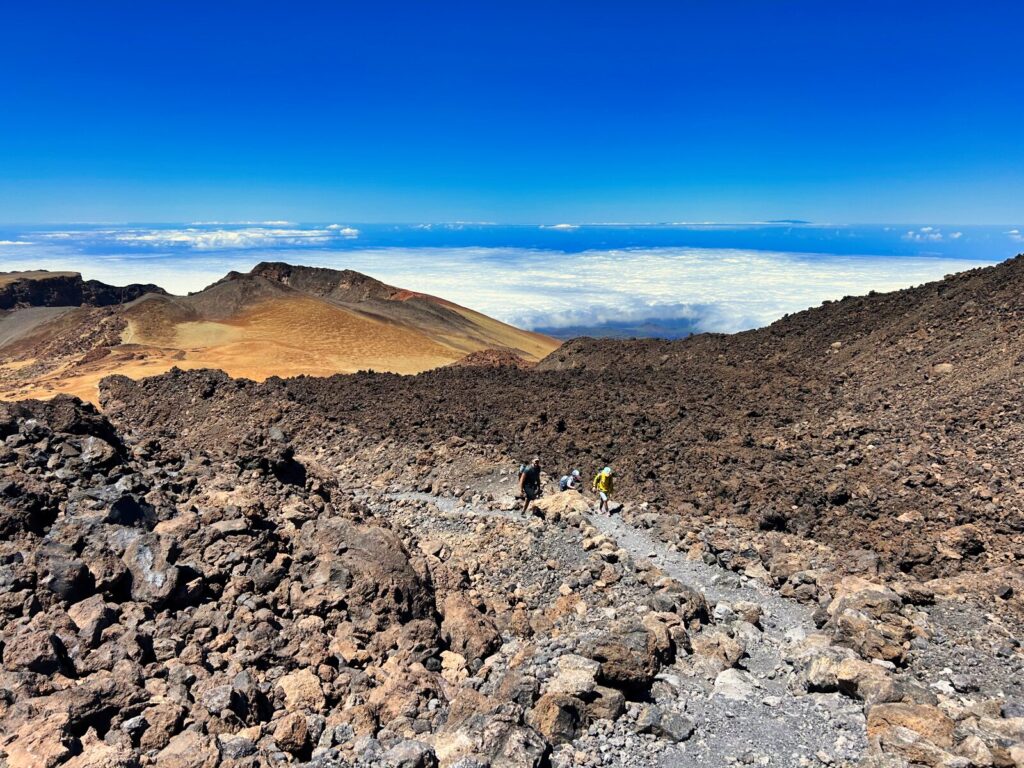
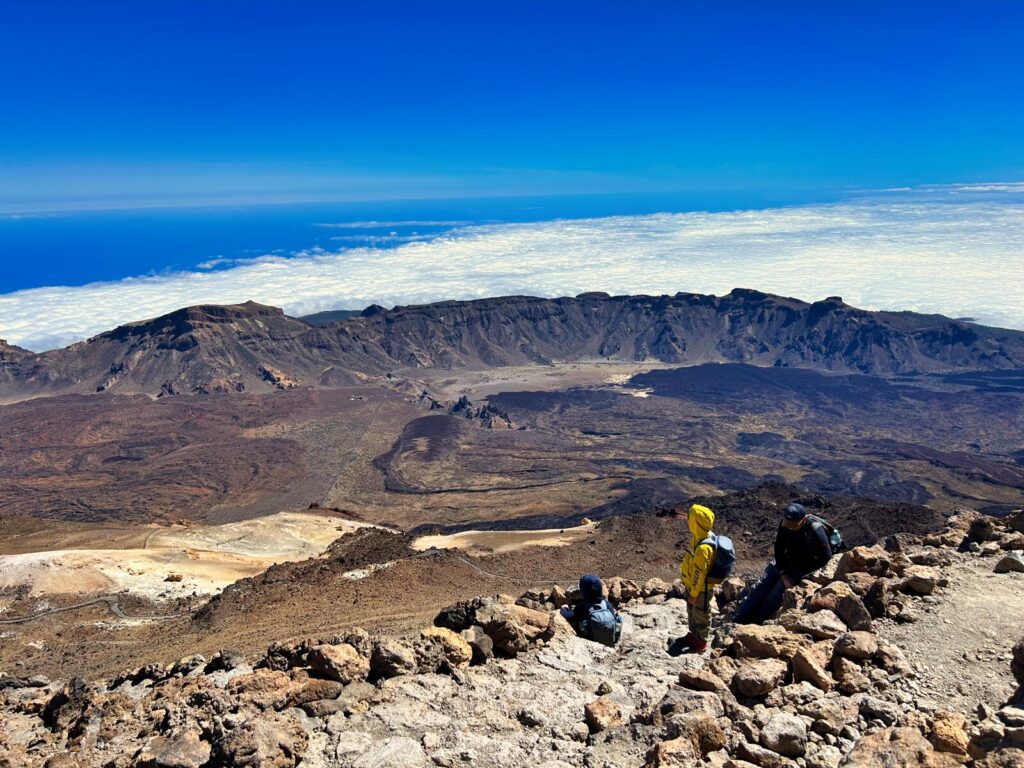
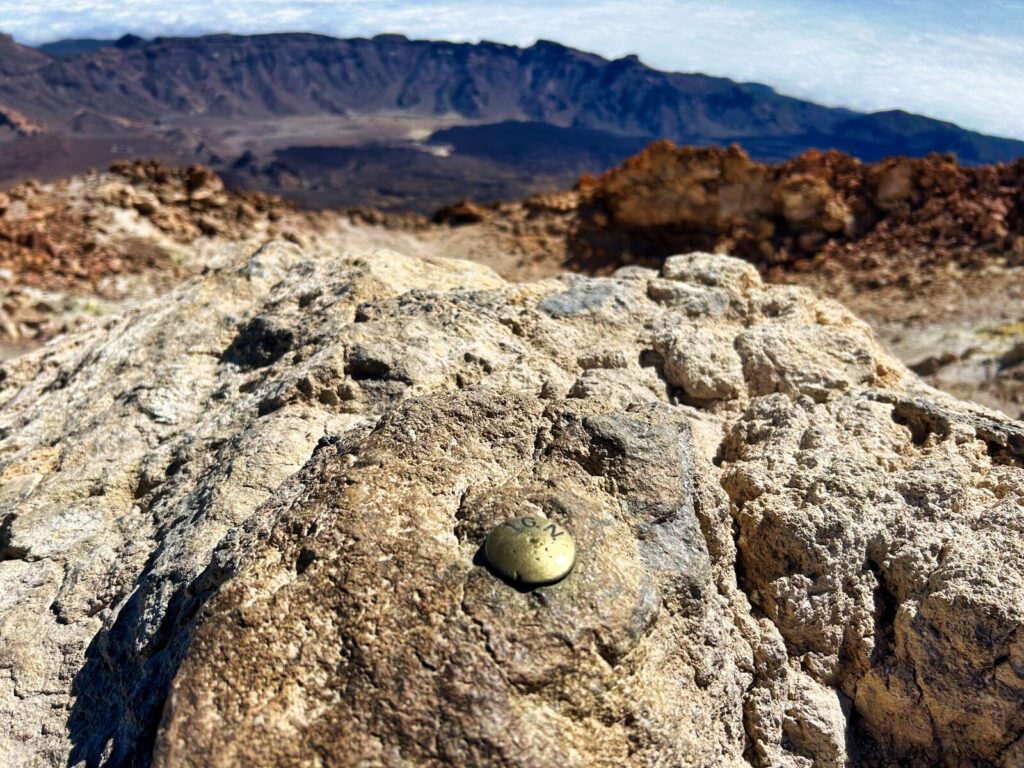
Option 4: Complete Hiking Experience (Most Challenging)
For Ultimate Adventure: Experienced mountaineers can combine ascent and descent entirely on foot, creating epic 12-16 hour adventures. Popular combinations include ascending via Montaña Blanca and descending via different routes, though this requires careful logistics planning and exceptional fitness.
Sunrise/Sunset Expeditions: Special permits allow summit access during magical golden hours. Sunrise climbs typically require 2:00-3:00 AM starts for Montaña Blanca route, while sunset permits offer spectacular evening views but require headlamp descents.
Preparing for Your Mount Teide Hike
Essential Equipment and Clothing
Clothing System (Crucial for Altitude Changes):
- Base layer: Moisture-wicking synthetic or merino wool
- Insulating layer: Fleece or down jacket (temperatures can drop to freezing)
- Outer shell: Windproof and waterproof jacket
- Legs: Hiking pants plus warm layer for summit conditions
- Extremities: Warm hat, sun hat, gloves, and neck protection
Footwear:
- Sturdy hiking boots with ankle support and aggressive tread
- Break in boots thoroughly before your hike
- Consider gaiters to prevent volcanic dust entry
- Avoid trail runners due to loose volcanic terrain
Essential Gear:
- Minimum 3 liters water per person (more for full ascent routes)
- High-energy snacks and full meals for longer routes
- Sunscreen SPF 50+ (UV intensity extreme at altitude)
- Sunglasses with UV protection
- Headlamp with extra batteries (essential for sunrise/sunset)
- First aid kit including altitude sickness medication
- Trekking poles (highly recommended for descent)
- Emergency blanket and whistle
Physical Preparation and Health Considerations
Fitness Requirements: Climbing Mount Teide demands good cardiovascular fitness and strong legs. The combination of altitude, steep terrain, and potentially harsh weather creates challenges even for experienced hikers. Begin training at least 6-8 weeks before your trip with regular cardio exercise and hill climbing.
Altitude Considerations: At 3,715 meters, Mount Teide’s summit sits well above the altitude where most people begin experiencing effects of reduced oxygen. Symptoms of altitude sickness include headaches, nausea, fatigue, and dizziness. Plan for slower ascent times and more frequent rest stops than at sea level.
Health Precautions: Consult your doctor before attempting this climb if you have cardiovascular issues, respiratory problems, or high blood pressure. Pregnant women and children under 3 years should avoid high-altitude exposure.
Weather and Seasonal Considerations
Understanding Teide’s Unique Climate
Mount Teide creates its own weather patterns, with conditions changing rapidly between base and summit. While coastal Tenerife enjoys warm, stable weather, the peak can experience snow, high winds, and freezing temperatures even in summer.
Temperature Variations:
- Base elevation (2,000m): Similar to coastal temperatures
- Cable car station (2,356m): 5-10°C cooler than coast
- Summit (3,715m): 15-20°C cooler than coast, can reach -10°C in winter
Seasonal Guide:
Summer (June-September):
- Best weather stability and longest daylight hours
- Summit temperatures: 5-15°C during day, can drop below freezing at night
- Highest demand for permits – book far in advance
- Heat at lower elevations requires very early starts
Winter (December-March):
- Summit often snow-covered with possible ice conditions
- Shorter daylight hours limit hiking windows
- Fewer crowds but weather more unpredictable
- Requires winter mountaineering equipment and experience
Spring/Autumn (April-May, October-November):
- Ideal climbing conditions with moderate temperatures
- Lower permit demand than summer
- Stable weather patterns with excellent visibility
- Perfect for photography with dramatic lighting
Weather Safety and Planning
Always check current conditions at www.aemet.es before your hike. The cable car frequently closes due to high winds, which can strand summit hikers who planned to descend mechanically. Monitor weather forecasts for several days before your climb and have backup plans ready.
Wind conditions deserve special attention – gusts above 3,000 meters can be dangerous even for experienced mountaineers. If sustained winds exceed 50 km/h, consider postponing your Mount Teide hike.
Safety Considerations and Emergency Procedures
Recognizing and Managing Altitude Sickness
Altitude sickness (acute mountain sickness) can affect anyone above 2,500 meters, regardless of fitness level. Early symptoms include headache, nausea, fatigue, and dizziness. More serious symptoms include confusion, difficulty walking, and shortness of breath at rest.
Prevention Strategies:
- Ascend gradually when possible
- Stay well-hydrated (but don’t overhydrate)
- Avoid alcohol and sleeping pills before climbing
- Eat light, high-carbohydrate meals
- Listen to your body and don’t ignore symptoms
When to Descend Immediately:
- Severe headache not relieved by rest and pain medication
- Vomiting or inability to keep food/water down
- Confusion or change in mental state
- Difficulty walking or coordination problems
- Shortness of breath at rest
Emergency Contacts and Procedures
Emergency Numbers:
- General Emergency: 112
- Civil Guard Mountain Rescue: 062
- Medical Emergency: 061
Emergency Preparedness: Inform someone of your climbing plans, including intended route, start time, and expected return. Carry a fully charged mobile phone, though coverage can be spotty above 3,000 meters. Consider carrying a personal locator beacon for remote routes.
Navigation and Route Finding
While main trails are well-marked, weather conditions can reduce visibility to mere meters. Download offline maps to your phone and carry a compass as backup. GPS coordinates for key waypoints:
- Montaña Blanca Trailhead: 28°16’22.8″N 16°35’45.6″W
- La Rambleta Cable Car Station: 28°15’29.4″N 16°37’44.4″W
- Teide Summit: 28°16’20.4″N 16°38’22.2″W
Logistics and Practical Information
Transportation to Trailheads
Driving to Mount Teide:
- From South (Los Cristianos): TF-21 via Vilaflor (45-60 minutes)
- From North (Puerto de la Cruz): TF-21 via La Orotava (45-60 minutes)
- From East (Santa Cruz): TF-24 direct route (60-75 minutes)
Roads to Teide National Park are well-maintained but steep and winding. In winter, chains may be required above 2,000 meters. Parking at trailheads fills early during peak season, so arrive before 8:00 AM.
Public Transportation: Limited bus service operates to the cable car base station:
- Line 348: From Puerto de la Cruz (once daily)
- Line 342: From Los Cristianos (once daily) Buses don’t serve hiking trailheads, making rental cars essential for hiking routes.
Accommodation Strategies
For Hiking Focus: Stay in locations providing easy access to multiple trailheads. Our Tenerife itinerary guide recommends central accommodations that optimize travel times to various Mount Teide routes.
Day Before Climbing: Stay hydrated, eat well, and get adequate sleep. Avoid alcohol and limit caffeine. Pack everything the night before and set multiple alarms – most serious climbs require pre-dawn starts.
Photography and Documentation
Mount Teide offers some of the world’s most spectacular mountain photography opportunities. The summit panorama encompasses all seven Canary Islands on clear days, with the African coast visible 300 kilometers away.
Best Photo Opportunities:
- Sunrise from summit (requires special permit and night ascent)
- View across Las Cañadas caldera during ascent
- Summit panorama with other Canary Islands
- Volcanic formations and endemic plant life
- “Sea of clouds” phenomenon from various elevations
Photography Equipment: Bring extra batteries (cold temperatures drain power quickly) and protect camera gear from volcanic dust. A polarizing filter helps manage intense UV reflection from light-colored volcanic surfaces.
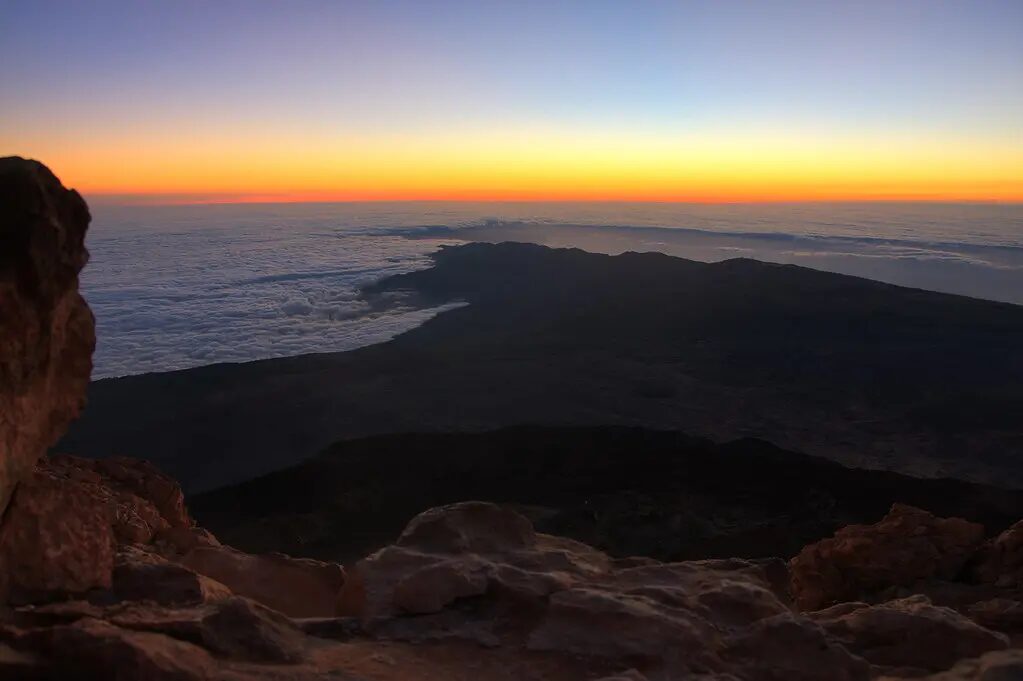
Alternatives When Permits Aren’t Available
Spectacular Viewpoints Without Permits
If Teide summit permits aren’t available, numerous alternatives offer incredible volcanic experiences:
From La Rambleta (Cable Car Access):
- Trail 11: Mirador de La Fortaleza (25-minute hike, 24m elevation gain)
- Trail 12: Mirador de Pico Viejo (30-minute hike, 54m elevation gain)
Both trails provide stunning panoramic views without requiring summit permits and showcase different perspectives of the volcanic landscape.
Other Teide National Park Hikes:
- Roques de García circuit (3.5km, 2 hours)
- Siete Cañadas trail (8km, 3 hours)
- Arenas Negras route (4km, 2 hours)
Our comprehensive Tenerife hiking guide details 15+ epic routes throughout the island, including alternatives when Teide permits aren’t available.
Stargazing Opportunities
Teide National Park holds “Starlight Reserve” certification, recognizing it as one of the world’s best astronomical observation sites. Even without climbing permits, nighttime visits offer incredible stargazing experiences above the cloud line.
Weather Patterns and Best Timing
Understanding Tenerife’s unique climate patterns helps optimize your Mount Teide hike experience. Our detailed Tenerife weather guide explains seasonal variations, but mountain conditions deserve special consideration.
Optimal Climbing Windows:
- April-June: Excellent conditions, moderate crowds, stable weather
- September-November: Perfect temperatures, fewer tourists, clear visibility
- July-August: Most reliable weather but highest demand for permits
- December-March: Advanced conditions, possible snow/ice, shorter daylight
Daily Weather Patterns: Mountain weather typically remains clearest during morning hours, with afternoon cloud buildup common. Plan summit attempts for early morning arrival when visibility is best and winds are typically calmest.
Common Mistakes and How to Avoid Them
Learning from others’ experiences can prevent costly errors during your Mount Teide hike. Our guide on what to avoid in Tenerife covers general island pitfalls, but mountain-specific mistakes include:
Underestimating Difficulty: Many visitors assume the cable car option makes this an easy walk. Even the final 650-meter summit trail challenges most hikers due to altitude and steepness.
Inadequate Weather Preparation: Coastal sunshine doesn’t predict summit conditions. Always pack warm layers and weather protection, even during summer visits.
Permit Confusion: Understanding which permits are required for your chosen route prevents disappointment. Double-check requirements and bring proper identification matching your reservation.
Insufficient Physical Preparation: Altitude amplifies physical demands significantly. Begin fitness preparation weeks before your trip, focusing on cardiovascular endurance and leg strength.
Frequently Asked Questions
No, accessing the summit requires a mandatory permit obtained through advance reservation. However, you can hike to La Rambleta cable car station and explore nearby viewpoints without permits.
Timing varies by route: cable car + summit (2-3 hours total), Montaña Blanca route (6-8 hours), Teide-Pico Viejo route (7-9 hours). Add extra time for photography and rest stops.
With proper preparation, permits, and weather awareness, Mount Teide climbing is relatively safe. Main risks include altitude sickness, weather changes, and loose volcanic terrain requiring sturdy footwear.
April-June and September-November offer optimal conditions with stable weather, moderate temperatures, and excellent visibility. Summer provides most reliable conditions but requires very early starts.
Children over 3 years can use the cable car, but summit hiking requires significant fitness and altitude tolerance. Assess individual capabilities carefully, as rescue at high altitude is complex.
Summit permits are free, but cable car tickets cost €41 round trip. Add parking, fuel, food, and equipment costs. Budget approximately €100-150 per person for a complete day experience including transportation.
Yes, you can walk up Mount Teide entirely on foot using several hiking routes. The popular Montaña Blanca trail covers 8.3km with 1,367m elevation gain, taking 5-6 hours to reach the cable car station plus additional time for the summit. All routes require advance permits and proper mountaineering preparation.
Mount Teide can be climbed safely by beginners using the cable car route, though the final summit trail remains challenging due to altitude. Full hiking routes require significant fitness and mountain experience. All climbers should prepare for rapid weather changes, altitude effects, and proper equipment needs regardless of experience level.
Your Mount Teide Adventure Awaits
A Mount Teide hike represents far more than simply reaching Spain’s highest point – it’s a journey through geological time, a test of personal limits, and an encounter with one of Europe’s most spectacular natural monuments. Whether you choose the accessibility of the cable car route or the challenge of hiking from sea level, the summit rewards every visitor with panoramic views that stretch across the entire Canary Islands archipelago and beyond to Africa’s coast.
The key to a successful Teide summit experience lies in thorough preparation: securing permits well in advance, understanding weather patterns, preparing physically for altitude challenges, and packing appropriate gear for rapidly changing mountain conditions. Respect for this active volcano’s power and natural beauty ensures both personal safety and preservation of this UNESCO World Heritage treasure for future generations.
Standing atop Pico del Teide at 3,715 meters, watching sunrise paint the Atlantic in brilliant colors while volcanic peaks emerge from seas of clouds below, creates memories that last a lifetime. This ultimate Canary Islands adventure combines geological wonder, physical achievement, and natural beauty in ways that few destinations on Earth can match.
Plan carefully, prepare thoroughly, and embrace the challenge – your Mount Teide summit awaits among the clouds above Spain’s most magnificent island paradise.

